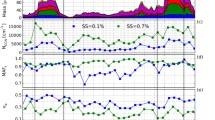Abstract
A microphysical model has been proposed to assess the scavenging of artificial aerosol particles from the atmosphere by raindrops, where the raindrops are regarded as a highly rarefied filtering medium. The effect of aerodynamic parameters of aerosol particles on the efficiency of their capture by raindrops E and on the scavenging coefficient Λ has been numerically investigated for different precipitation rates I. A new formula has been proposed to evaluate the efficiency of aerosol capture by the raindrops. This model has been compared with other well-known models. The proposed model has been found to describe the interaction between aerosol particles and raindrops more strictly than the microphysical models considered in this study.





Similar content being viewed by others
REFERENCES
B. I. Ogorodnikov, A. K. Budyka, V. I. Skitovich, and A. V. Brodovoi, “Characteristics of aerosols in the boundary layer of the atmosphere over Moscow,” Izv., Atmos. Ocean. Phys. 32 (2), 149–157 (1996).
A. K. Budyka and B. I. Ogorodnikov, “Radioactive aerosols generated by Chernobyl,” Russ. J. Phys. Chem. A 73 (2), 310–319 (1999).
D. B. Turner, Workbook of Atmospheric Dispersion Estimates: An Introduction to Dispersion Modeling, 2nd ed. (CRC Press, Ann Arbor MI, 1994).
J. Brioude, D. Arnold, A. Stohl, et al., “Lagrangian particle dispersion model FLEXPART-WRF version 3.1,” Geosci. Model Dev. 6, 1889–1904 (2013).
V. V. Belikov, V. M. Goloviznin, V. N. Semenov, et al., “NOSTRADAMUS computer system of radiation conditions forecasting. Atmospheric admixture transport model verification,” in Proc. IBRAE. Simulation of Environmental Radionuclide Spread (Nauka, Moscow, 2008) [in Russian], pp. 41–103
Meteorology and Nuclear Energy, Ed. by N. L. Byzova (Gidrometeoizdat, Leningrad, 1971) [in Russian].
I. Langmuir, “The production of rain by a chain reaction in cumulus clouds at temperatures above freezing,” J. Meteorol. 5, 175–192 (1948).
A. C. Chamberlain, Aspects of Travel and Deposition of Aerosol and Vapor Clouds. AERE HP/R 1261 (Atomic Energy Research Establishment, Harwell, Berkshire, England, 1953).
B. J. Mason, The Physics of Clouds (Oxford University Press, Oxford, 1957).
F. G. May, “The washout of Lycopodium spores by rain,” Q. J. R. Meteorol. Soc. 84, 451–485 (1958).
G. D. Kinzer and W. E. Cobb, “Laboratory measurements and analysis of the growth and collection efficiency of cloud droplets,” J. Meteorol. 15 (2), 138–148 (1958).
I. I. Burtsev, “On the washout of artificial radioactive aerosols from the atmosphere by precipitation,” in Radioactive Isotopes in the Atmosphere and Their Use in Meteorology (Atomizdat, Moscow, 1965), p. 217 [in Russian].
J. S. Marshall and W. M. Palmer, “The distribution of raindrops with size,” J. Meteorol. 5 (2), 165–166 (1948).
A. Balklanov and J. H. Sørensen, “Parameterization of radionuclide deposition in atmospheric long-range transport modelling,” Phys. Chem. Earth (B) 26, 787–799 (2001).
H. Webster and D. Thomson, The NAME Wet Deposition Scheme. Forecasting Research Technical Report No. 584 (Met Office, UK, 2014).
C. Andronache, “Estimated variability of below-cloud aerosol removal by rainfall for observed aerosol size distribution,” Atmos. Chem. Phys. 3, 131–143 (2003).
G. A. Loosmore and R. T. Cederwall, “Precipitation scavenging of atmospheric aerosols for emergency response applications: testing an updated model with new real-time data,” Atmos. Environ. 38, 993–1003 (2004).
K. P. Makhon’ko and G. V. Dmitrieva, “The capacity of different precipitation types for washing fission products out of the atmosphere and washing-out characteristics,” Izv. Akad. Nauk SSSR, Fiz. Atmos. Okeana. 2 (3), 297–304 (1966).
W. G. N. Slinn, “Precipitation scavenging,” in Atmospheric Sciences and Power Production, Ed. by D. Raderson (U.S. Department of Energy, Washington DC, 1983), pp. 466–532.
F. Pasquill, “The estimation of the dispersion of windborne material,” Meteorol. Mag., 90 (1063), 33–49 (1961).
S. Greenfield, “Rain scavenging of radioactive particulate matter from the atmosphere,” J. Meteorol. 14 (2), 115–125 (1957).
R. V. Arutyunyan, D. A. Pripachkin, V. N. Semenov, et al., Preprint No. IBRAE (Keldysh Institute of Applied Mathematics, 2016).
M. Giardina and P. Buffa, “A new approach for modeling dry deposition velocity of particles,” Atmos. Environ. 180, 11–22 (2018).
J. Seinfeld and S. Pandis, Atmospheric Chemistry and Physics. From Air Pollution to Climate Change (John Wiley & Sons, New York, 2006).
Author information
Authors and Affiliations
Corresponding author
Additional information
Translated by V. Arutyunyan
Rights and permissions
About this article
Cite this article
Pripachkin, D.A., Budyka, A.K. Influence of Aerosol Particle Parameters on Their Scavenging from the Atmosphere by Raindrops. Izv. Atmos. Ocean. Phys. 56, 173–178 (2020). https://doi.org/10.1134/S0001433820020103
Received:
Revised:
Accepted:
Published:
Issue Date:
DOI: https://doi.org/10.1134/S0001433820020103




